Abstract
In the vast majority of sports, as well as in alpine skiing, the value of sports performance has increased greatly, which has led to the intensification of sports competition spectacularity. Thus, increasing the training efficiency becomes mandatory both for coaches and athletes. The aim of the research is to identify efficient methods and means to optimise non-specific (land-based) and specific (on-snow) training in alpine skiing so that the best performance can be achieved. In order to carry out the research (case study), the athlete was assessed and measured using the Optojump analysis and measurement system by applying three tests: 60sec plyometric jumps, left-leg squat jump - 5 jumps and right-leg squat jump - 5 jumps in the precompetition and competition phases. This system recorded the results during the tests, giving us the opportunity to view the data recorded at any moment of the tests and to compare the performances in different tests. The research was conducted over 6 months of training, during which we used customised training programs, as well as participation in two rounds of the Alpine Ski World Cup, namely in two events – Downhill and Super G. The training programs proposed in the non-specific (land-based) training accepted by the athlete proved to be viable and efficient, this also being supported by the data obtained in the tests performed, while the results from the competitions emphasise the need to improve the specific training from the technical and tactical viewpoints.
Keywords: Specific and non-specific trainingOptojumpalpine skiing
Introduction
Nowadays, thanks to sports specialists around the world who are constantly concerned with new methodological and practical searches, a whole series of sports have turned into high-level disciplines, including alpine skiing.
More than a sport, skiing is nowadays an activity in itself that influences and determines an important sector of the human activity and owes its importance and scale to strong social integration, which is a feature common to sports in general (Pelin, 2008).
Alpine skiing is a sports discipline “with its own field of expression, materialised by the content and execution of the competition events, which present an increased degree of complexity, dynamism, technique, difficulty, showmanship, elegance” (Toader, 2017, p. 4).
Problem Statement
In alpine skiing, the non-specific (land-based) training must not be dissociated and planned independently from the specific (on-snow) training and the whole complexity of the sports performance.
We know that, in skiing, the training process has as its central focus the on-snow training, and this is planned, completed and preventively ensured by the land-based training.
In order to analyse the data obtained in the training and compare them with the existing models worldwide, we used the computer. We also used it to establish workload schedules based on the best performances of each athlete, the prescriptions for training sessions and the design and planning of activities (development of prospects per Olympic cycle, annual plans, stage plans, micro-cycles and training plans) (Tudor, Moanţă, & Ghițescu, 2013).
Therefore, in this study, we used the OptoJump analysis and measurement system by which three tests were applied: 60sec plyometric jumps, left-leg squat jump - 5 jumps and right-leg squat jump - 5 jumps. Optojump is one of the most advanced and high-performance systems for physical fitness assessment, being very efficient in the training of top-performance athletes, with notable influences on their competition results (The next level of athletic fitness training, 2011).
This system of analysis and measurement has been used in various studies (Graur & Făgăraş, 2013; Bosquet, Berryman, & Dupuy, 2009; Lehance, Croisier, & Bury, 2005), “which attests to the validity of the results obtained, the accessibility, through the lower cost, its portability versus other assessment tools, and its versatility that allows its use in assessment and research under specific conditions of both jumping and walking and also running” (Becea, Pelin, Braneț, & Răchită, 2017).
What we intend through this study is to complete and define, as far as possible, certain aspects of this theme and perhaps to start new research directions.
Research Questions
If the specific (on-snow) and non-specific (land-based) training level of alpine skiers is known, are coaches helped to guide the training to achieve performance?
Purpose of the Study
We aimed to identify efficient methods and means to optimise non-specific (land-based) and specific (on-snow) training in alpine skiing to achieve the best performance.
Research Methods
Research subject and location
In order to carry out the research experiment, one Romanian athlete (A.V.) was subjected to this case-study research.
Before the experiment, the subject was verbally informed on the particularities of the test and the types of assessment used. He agreed to the way the experiment was conducted.
The research was conducted during 6 months of training, between July and December 2017, during which we used customised training programs, as well as participations in two rounds of the Alpine Ski World Cup, in two events – Downhill and Super G. The research was carried out in this way:
on July 2, 2017, the initial test was carried out by applying the tests: 60sec plyometric jumps, left-leg squat jump
- 5 jumps and right-leg squat jump- 5 jumps in Poiana Brasov;between July 3 and December 16, 2017, the training programs were applied to both the specific and non-specific training;
in November and December - participation in the two stages of the Alpine Ski World Cup;
on December 17, 2017, the final test was carried out by applying the three tests in Poiana Brasov.
Research techniques used
The following research methods were used: scientific documentation by which the theoretical foundation of the paper was laid, the experimental method, the graphical method and the test and measurement method.
In order to carry out the research (case study), the athlete was assessed and measured using the Optojump analysis and measurement system by applying three tests:
60sec plyometric jumps: starting position from standing, executing for 1 minute as many jumps as possible;
left-leg squat jump - 5 jumps: starting position from standing on the left foot with the hands on the hip, with executing five successive jumps;
right-leg squat jump - 5 jumps: starting position from standing on the right foot with the hands on the hip, with executing five successive jumps.
In our research, we used the Optojump system to assess anaerobic endurance strength and explosive strength. The data presentation was both tabular and graphical.
Findings
By applying the 60sec plyometric jumps test, we determined the level of anaerobic endurance strength, i.e. the relation between the upper level of expressing explosive c and maximum strength. Through this testing, we followed the maximum and minimum jump values and constancy in the initial and final tests). The number of repeats was the maximum expressed within 60sec. We calculated the height of each jump, the arithmetic mean and the difference between the maximum and minimum jumps (Table
In the initial test (Figure
In the final test (Figure
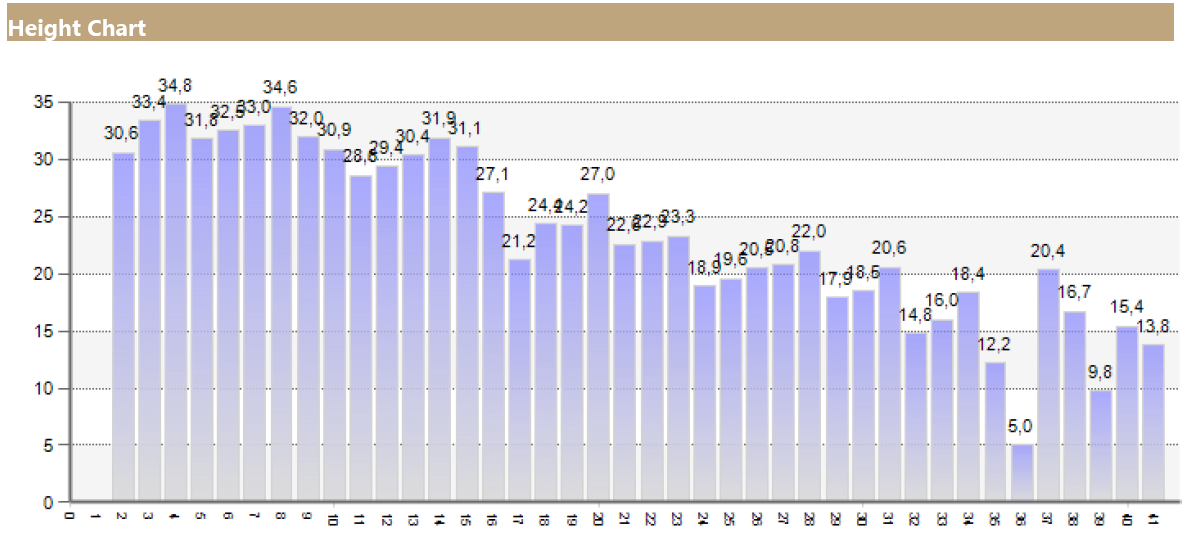
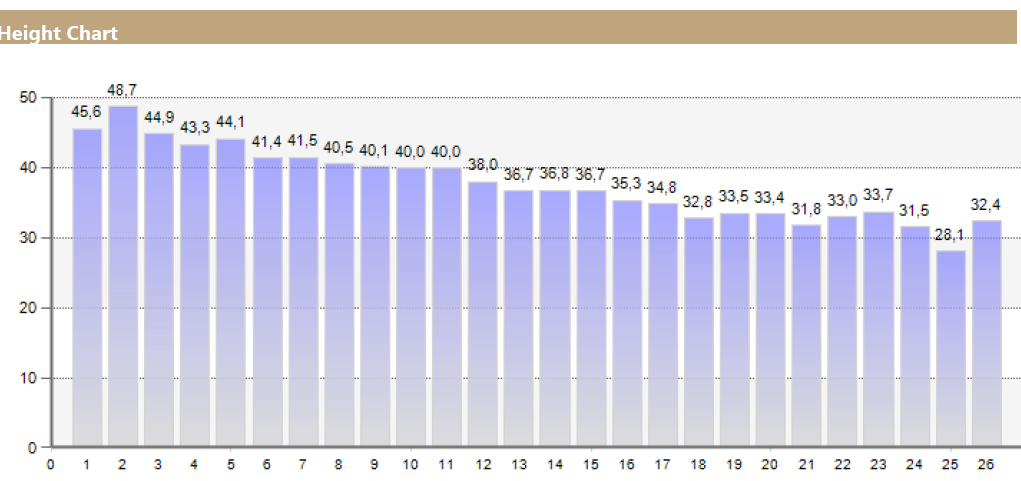
Between the two tests, the training focused on developing explosive strength and endurance strength.
By applying the left-leg squat jump - 5 jumps and right-leg squat jump - 5 jumps, the level of expression of the explosive strength was determined for both the left and right foot. The maximum and minimum values were achieved in the 5 jumps by the explosive execution, both concentrated and at maximum for each repeat.We calculated the height of each jump, the arithmetic mean, and the difference between the maximum and minimum jumps (Table
For the right-leg squat jump
In the final test (Figure
We can see that the progress achieved between the two tests is 5.2cm for the maximum jump and 5.8cm for the minimum jump.
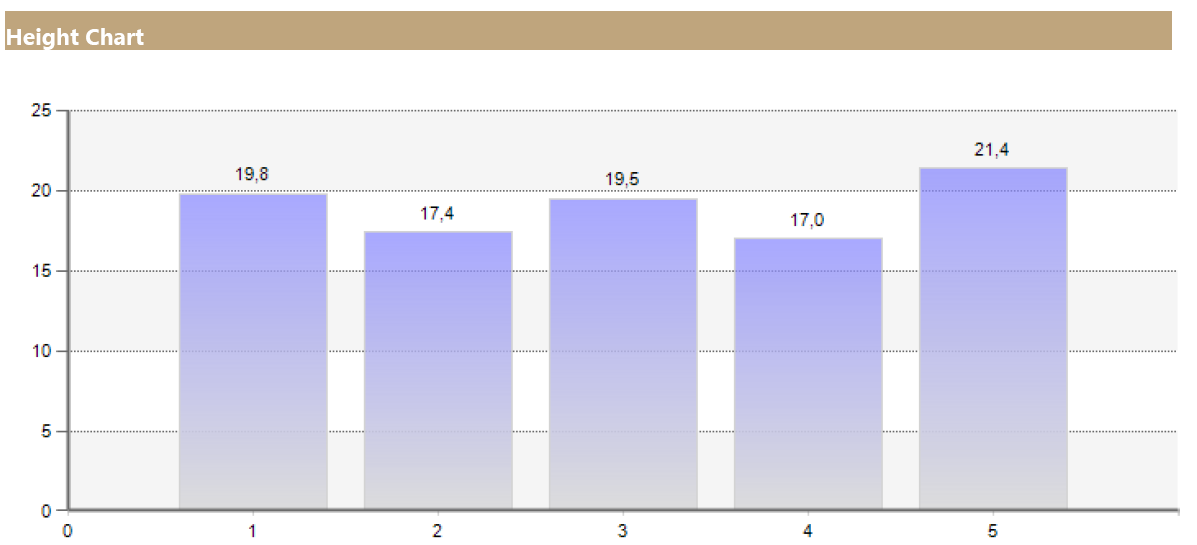
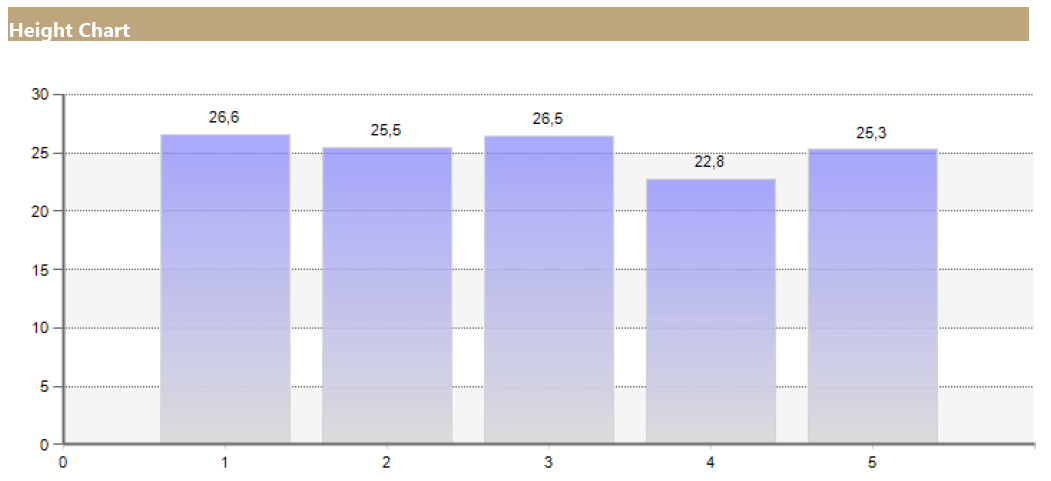
In the initial test (Figure
In the final test (Figure
We can note that the progress between the two tests is 5.7cm for the best height jump and 6.8cm for the lowest height jump.
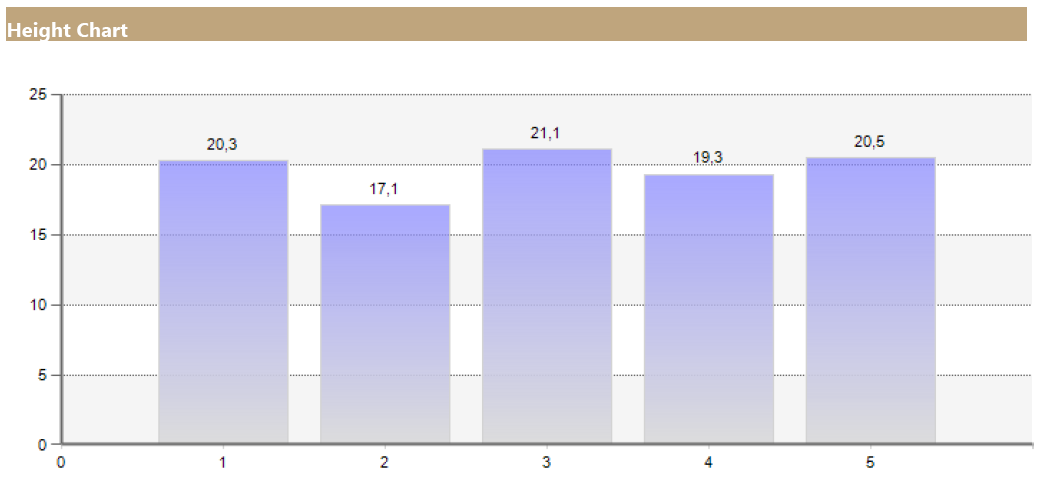
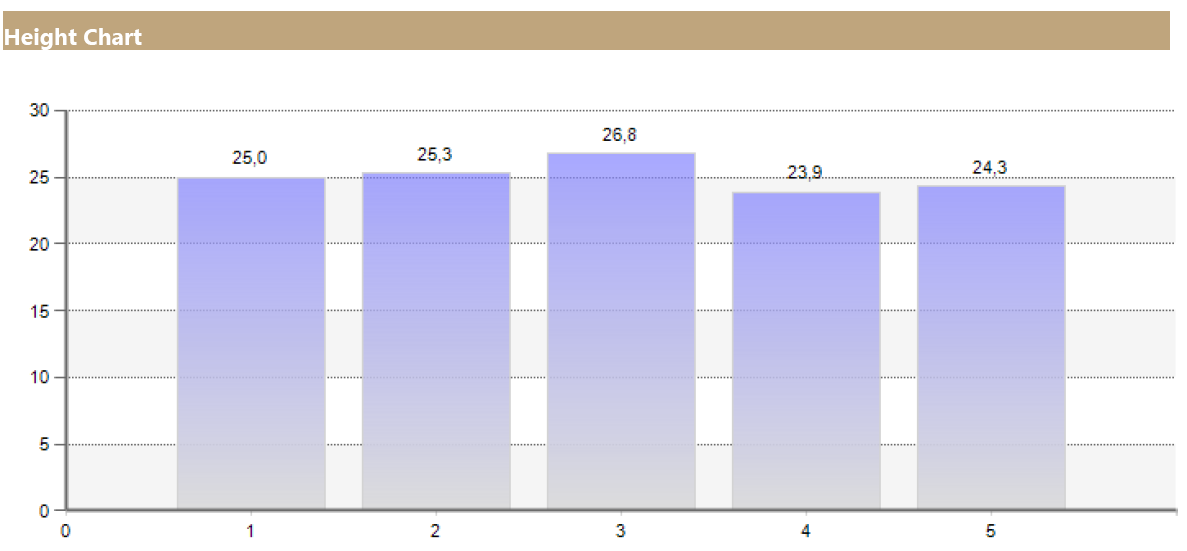
Between the initial and final tests, we intervened by using means to improve the explosive strength, which were in the 40-60% range of the individual maximum strength. The preparation during training sessions focused on developing the rapid strength with average resistance and the reactive strength through procedures combining different contraction speeds of the muscle fiber (slow, eccentric speed followed by rapid, concentric speed).
The on-snow training aimed at developing the specific effort capacity, as well as the motor qualities combined based on priority and involved based on differences, ultimately determining the specific efficiency in the speed tests (Downhill and Super G).
The results obtained in competitions by A.V., after participating in the two stages of the Downhill and Super G events at the Alpine Ski World Cup at Lake Louise (Canada) and Beaver Creeak (the US), are shown in Table
As shown in Table
Conclusion
The results of the research clearly and concretely highlighted the role and importance of the non-specific training and the training programs applied in sports performance.
The training programs proposed in the non-specific training (land-based) accepted by the athlete proved to be viable and effective, this being supported by the data obtained during the tests performed, while the results from the competitions emphasised the need to improve the specific training from a technical-tactical viewpoint, the differences between the results obtained in the competitions being low.
As the sports mastery grows, the “specific difficulty” of the specific training increases. Thus, for the Downhill and Super G events, the specific training (on snow) must be done with strictly specialised means that develop the combinations of qualities that are prioritarily determined by the particularities of alpine skiing, the muscle groups engaged in effort, the type of demand and the subjective factors: the state of the snow, the weather conditions and the difficulty of the slopes.
In alpine skiing competitions, the level of performance is determined not only by the training programs, but also by a number of infrastructure factors, including the technical staff, physiotherapists, service-men and participation in many high-level competitions.
In conclusion, there is a close relation (from general to particular) between the specific and non-specific types of training, both conditioning the performance of the athlete.
Due to the fact that this research includes only one participating subject, being a case-study type, we consider that we cannot generalise the conclusions drawn, but we believe that the results obtained can open new directions of research.
Acknowledgments
This work was funded by University Politehnica of Bucharest, through the “Excellence Research Grants” Program. Identifier: UPB-GEX 2017, Ctr. No. 97/2017 (POSOSTU)
References
- Becea, L., Pelin, R. A., Braneț, C., & Răchită, I. (2017). A comparative study on the indirect assessment of leg extensor power using simultaneously the Jump-and-Reach Test from Alpha-Fit and the Optojump system. In Proceedings of the 13th International Scientific Conference “eLearning and Software for Education”, April 27-28, 2017 (Vol. 3, pp. 154-160). Bucharest: “Carol I” NDU Publishing House. https://dx.doi.org/ 10.12753/2066-026X-17-196
- Bosquet, L., Berryman, N., & Dupuy O. (2009). A comparison of 2 optical timing systems designed to measure flight time and contact time during jumping and hopping. Journal of Strength and Conditioning Research, 23(9), 2660-2665.
- Graur, C., & Făgăraş, S. P. (2013). Differences in the explosive force of the lower limbs between female volleyball teams. Palestrica of the third millennium ‒ Civilization and Sport, 14(4), 288-291.
- Lehance, C., Croisier, J. L., & Bury, T. (2005). Optojump system efficiency in the assessment of lower limbs explosive strength. Science & Sports, 20(3), 131-135.
- Pelin, R. (2008). Tehnica și metodica învățării schiului alpin pentru studenții din învățământul superior tehnic. București: Printech.
- The next level of athletic fitness training: How OptoJump is helping athletes achieve physical superiority. (2011). Bigger Faster Stronger, November/December, 34-37. Retrieved from http://www.optojump.com/optojumpnext/media/articles/bfs/1111-next-level-oj.pdf
- Toader, S. D. (2017). Optimizarea pregătirii fizice pe uscat în schiul alpin de performanță la juniori (Teză de doctorat). UNEFS București.
- Tudor, V., Moanţă, A., & Ghițescu, I. (2013). Computer utilization in motor activities – Opportunities and limitations. In Proceedings of the International Scientific Conference “eLearning and Software for Education”, April 27-28, 2017 (Vol. 3, pp. 185-190). Bucharest: “Carol I” NDU Publishing House. https://dx.doi.org/ 10.12753/2066-026X-13-244
Copyright information

This work is licensed under a Creative Commons Attribution-NonCommercial-NoDerivatives 4.0 International License.
About this article
Publication Date
16 February 2019
Article Doi
eBook ISBN
978-1-80296-054-9
Publisher
Future Academy
Volume
55
Print ISBN (optional)
-
Edition Number
1st Edition
Pages
1-752
Subjects
Sports, sport science, physical education
Cite this article as:
Răchită, I., Pelin, R. A., Grigoroiu, C., & Netolitzchi, M. (2019). The Role Of Specific And Non-Specific Training In Alpine Skiing. In V. Grigore, M. Stănescu, M. Stoicescu, & L. Popescu (Eds.), Education and Sports Science in the 21st Century, vol 55. European Proceedings of Social and Behavioural Sciences (pp. 423-431). Future Academy. https://doi.org/10.15405/epsbs.2019.02.53
